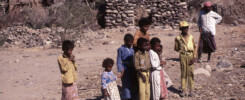Shada Nabil
Salma – a 35-year-old woman – leaves her house everyday carrying her young daughter. She climbs into an open-air truck for street cleaning workers to carry out her daily duties till midday, after which she then goes on to the streets of Mukalla city to sell napkins. Before the day is over, she goes home to her one-room tin shack on the edge of the city carrying some food.
Her daily journey is usually filled with harassment and attempts to rob her of her freedom and sometimes her dignity. For even though she spends more than half her day working under the heat of the sun, she still has to face some of whom view her as prey and try to harass her verbally and assault her dignity with insults and slander.
Street Violence
The Muhamasheen (Marginalized) society is somewhat characterized as being a freer society within its members. As a result of the social situation that suffocates them, the Muhamasheen families live in a kind of symbiotic life among themselves, but this does not prevent women in this society from suffering from double marginalization in different ways. Muhamasheen women are more involved in work than other women in society. However, this makes them more vulnerable to harassment. A study involving a 100 women and men conducted in the capital Sana’a, on street violence against women showed that women are exposed to more forms of psychological violence (adverse and harassment) than physical violence[1]. And seeing that most of the women working on the streets in Yemen are Muhamasheen women, that makes them 90% more likely to be harassed.
Salma, who cannot read or write, says that her salary in the cleaning sector is not enough for her and her children, which forces her to go out to sell napkins to further provide for them. With the recent war, prices have doubled with no increase in salaries followed by a reduction in income sources. This has doubled problems for Salama and other women like her, in addition to the already raising challenges to this group brought by this war.
War & Violence
The recent war has made life a living hell for women, children and the rest of society. However, the problems facing Muhamasheen women have multiplied within their society. These women pay a higher price during these times of war in various forms, suffering the multiplying human and social effects of the conflict or through the increased severity of violations against them.
As a result of the armed conflict, the number of female breadwinners has tripled from pre-war levels, which has multiplied the burden on women with scarce resources, rising food prices, and a sharp decline in agricultural production, a field in which women account for about 80 percent of the labor force[2]. Muhamasheen women are highly involved in the workforce, and it could be argued that if they were given the chance, they would be even more involved, either in the cleaning sector or in other fields. However, the current war has strongly affected them, with job opportunities and revenues diminishing on one hand, and the rise of violations on the other.
According to a research by Aisha al-Warraq on the Muhamasheen, women and girls from this group of society have faced a greater risk of gender-based assaults than any other women in other groups. Muhamasheen women were among the most vulnerable to sexual violence and harassment by combatants[3]. In fact, it was not only the combatants, but also other individuals who continued to attack the Muhamasheen and the women in particular, because they were the most vulnerable, and were unable to fend for themselves in the absence of authorities to protect them or to claim their rights.
The plight that Salma and other Muhamasheen women face is not only because they are of this particular group, but because they are also women. This makes them trapped within a series of marginalization’s, once because they are women within a society that marginalizes women and deprives them of their legitimate rights, and once because they are part of the socially isolated Muhamasheen society.
Exploitation
In another phenomenon, which reflects not only the miserable situation of the Muhamasheen society, but also somehow illustrates the life of women within this group, being deprived of education and the right to a normal life has become the norm. This has led to many social problems, which they alone suffer the consciences under the prevailing illiteracy and lack of social solidarity which could protect them from all these serious consequences and society as well. Young Muhamasheen girls are either being exploited, harassed, trafficked, or made to beg illegally. There are some brokers and gangsters who have groups of street children and little girls, which they send out daily to collect money from designated places for daily wages[4]. These proceeds illegally end up with those brokers who earn by exploiting these children. There are no institutions or associations that protect them from such systematic violations, nor is there a social deterrent to such degrading and inhuman practices.
This exploitation does not stop there, as Saida – a 41-year-old woman – stated that there are some people who use her and other Muhamasheen women like her to do hard work, such as the cleaning of places that others refuse to do so. All of this in return for meager wagers, as they are often viewed to have been created only to serve and that they were lesser human beings.
Is There a Solution in the Horizon?
The Constitution of the Republic of Yemen contains Article 31, which stipulates that “Women are Sisters of Men, and as such are entitled to Rights & Duties Guaranteed by Legislation & Law”[5]. The text appeared to be inconclusive in the way it views women in regards to equality, and how to address their problems. Instead, we find that this matter was left in the hands of clerics, who failed to produce a single law that would strengthen the role of women in society. Furthermore, the Constitution did not contain any provision concerning the Muhamasheen. After the year 1990, the state of closure of women and social traditions restricting their participation in society increased, at a time when economic and social problems surged and the population doubled, with women becoming a larger percentage of the overall society. This in turn is reflected more tragically on Muhamasheen, and on Muhamasheen women in particular.
On the other hand, the proposed Constitution, which was the result of the 2015 National Dialogue Conference[6], contains two articles on women: Article 38, which states that “The State Shall Ensure the Active Participation of Women in the Investment Sector, Economic Development, Providing Support & the Encouragement of Rural Women in Various Fields”, and Article 57, which stipulates that “The State is Committed to the Support & Nurturing of Women & Enacting Laws that Guarantee their Protection, Raising their Status in society & Eliminating the Negative Culture & Social Customs that Undermine their Dignity”. The Constitution also includes an article on the Muhamasheen, which states that “The State is Obligated to take Legislative & Executive Measures to Promote the Situation of Vulnerable & Marginalized Groups, & to Promote their Active Participation in Political, Economic & Social Life. This reflects the fact that the authors of this draft recognize that women are a vulnerable group in society, and at the same time that women within the Muhamasheen community are twice as vulnerable.
The solution, as it appears from the text above, is to have legislative measures in place. However, it is also imperative to change the negative cultural patterns and customs that are hostile towards an important part of society. This in turn, will not only benefit women and the Muhamasheen community, but Yemeni society as a whole, which they are an essential part of. Any attempt to seek a radical solution to the problems of women in Yemen should start from searching for solutions for the problems of Muhamasheen women, as they suffer from marginalization on serval different levels, be it race or gender marginalization.
Footnotes:
[1] Women on the Sidewalks of Sana’a – Vulnerable to Harassment & Extortion, Mohammed Abdulmalik, Al-Arabi Al-Gadid, March 16, 2015.
[2] The Situation of Women in Yemen during the Armed Conflict, Second Annual Report on the Situation of Women in Politics in the Arab Region 2018, Forum on Women in Politics in the Arab Region.
[3] Historical & Systematic Marginalization of the Muhamasheen community in Yemen, Aisha al-Warraq, Sana’a Center for Strategic Studies, May 31, 2019.
[4] Women on the Sidewalks of Sana’a – Vulnerable to Harassment & Extortion, Mohammed Abdulmalik.
[5] The Constitution of the Republic of Yemen, p. 6.
[6] View articles referred to in the draft constitution of the Republic of Yemen written by the Constitution Drafting Committee in 2015, which was supposed to undergo voting if not for the current war which put an end to everything, p: 9, 11.



